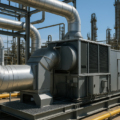Energy efficiency is a key pillar in the operation of industrial plants, especially in the oil and gas sector, where energy-intensive use represents a significant cost in daily operations.
In the climate conditions of West Odessa, Texas, where extreme temperatures are common, heating, ventilation, and air conditioning (HVAC) systems play a crucial role.
Therefore, properly optimized HVAC systems not only improve the work environment for employees but also significantly reduce operational costs by minimizing energy consumption.
In this regard, here are six key aspects of how HVAC systems can optimize energy efficiency in an oil and gas industrial plant and how to implement effective strategies in this area.
1. Demand analysis and proper sizing of the HVAC system
One common mistake in industrial facilities in the oil and gas sector is over-sizing or under-sizing HVAC systems.
An HVAC system that is not properly sized for the specific needs of the plant will not only be less efficient but will also wear out faster.
Demand analysis allows for accurately estimating the thermal load that each area requires, adjusting the system to provide the proper level of heating and cooling without excess. Proper system design can prevent energy loss and improve performance.
2. Preventive and corrective HVAC maintenance in West Texas
HVAC systems operate continuously in oil and gas industrial plants, and without proper maintenance, they tend to lose efficiency. Dirty filters, duct blockages, and worn-out components increase energy consumption.
A well-structured preventive and corrective maintenance program, including regular equipment inspections, filter cleaning, and ventilation system adjustments, can reduce energy consumption by up to 15% in industrial plants.
Regular inspections also help identify potential issues before they affect plant operations, extending the lifespan of the equipment.
3. Automation and smart control of HVAC systems
Smart control technology applied to HVAC systems allows for optimal energy consumption management. By using temperature, humidity, and occupancy sensors, the HVAC system can automatically adjust based on actual demand in each area of the plant.
This immediate responsiveness avoids excessive energy use in under-occupied areas and ensures the system operates only when needed.
The implementation of integrated Energy Management Systems (EMS) allows scheduling equipment operation during low-demand hours and reducing consumption during peak energy cost periods.
4. Use of energy recoverers and efficient ventilation systems
Energy recovery systems are technologies that allow for harnessing heat or cold generated in one area and reusing it in another, optimizing energy consumption in the plant. In an oil and gas plant, exhaust air can be an energy source that is wasted if not recovered efficiently.
By using heat recovery units in ventilation systems, the load on heating or cooling systems can be reduced, achieving significant energy cost savings.
Controlled mechanical ventilation also allows adjusting air flow based on both exterior and interior temperature, improving comfort and reducing consumption.
5. Thermal insulation and control of thermal bridges
In industrial facilities, thermal insulation is essential for maintaining the desired temperature and reducing demand on HVAC systems.
Proper insulation in ducts, pipes, and equipment minimizes energy loss during air transport and ensures that the HVAC system maintains the ideal temperature without additional effort.
Additionally, controlling thermal bridges (areas where heat or cold is lost to the exterior) prevents system overload and reduces energy consumption.
6. Energy audits and performance analysis
Energy audits are a vital part of HVAC services for the oil and gas industry, helping identify opportunities for energy efficiency improvement. These audits allow plant managers to detect high-consumption areas, energy leaks, and potential inefficiencies in the equipment.
Based on these analyses, specific measures can be implemented to optimize system performance and generate significant savings.
Furthermore, continuous monitoring of HVAC system performance using Energy Management Systems enables real-time consumption control. This provides plant managers with accurate data to adjust the system as needed and improve long-term energy efficiency.
What to do to optimize HVAC energy efficiency in your oil and gas plant?
Optimizing HVAC systems is a crucial component to improving energy efficiency in the oil and gas industry in West Texas. From selecting the right equipment to using advanced automation and energy recovery technologies, every step toward optimization reduces consumption and associated costs while enhancing the work environment.
With a comprehensive approach and proper support, plant managers can maximize HVAC system performance and contribute to a more sustainable and profitable operation.
At Doctor Frío A/C and Heating, we offer complete HVAC installation and maintenance solutions for oil and gas plants in the Permian Basin, Texas. This way, you can operate efficiently, save costs, and improve productivity. Contact one of our advisors to discover how we can help you achieve your energy efficiency goals.




